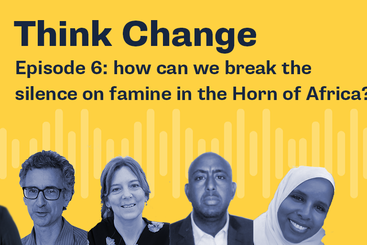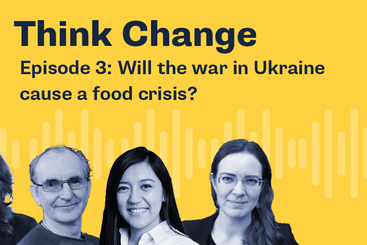In 2018, the Intergovernmental Panel on Climate Change compared a 1.5°C world to a 2°C world of heating. This additional 0.5°C of heating, the IPCC found, would expose 330 million more people to nutritional risks. Ominously, humanity is currently on track for an average global temperature rise of nearly 3°C.
Today, at 1.2°C of warming, many countries are already experiencing food shortages — including Egypt, which holds the Presidency of COP27. Egypt takes part in the Africa Group of Negotiators: it sees its Presidency as a chance to voice African concerns about climate change. While much of the debate about climate change concerns energy transitions, COP27 takes place against a backdrop of food insecurity and even famine, threatening the continent in ways not seen since the late 2000s and early 2010s. Current food crises could devastate the livelihoods and prospects of millions; they foreshadow a future of climate-driven food emergencies.
What’s causing the food crisis?
The finger of blame has frequently been pointed at Russia’s war on Ukraine — with good reason. Ukraine provides a great deal of the world’s wheat, corn, barley and sunflower oil, and its shipments have been blockaded for much of the year. Russia is an even larger producer of food and fertiliser but faces obstacles to export due to Western sanctions.
Moreover, for countries that rely heavily on imported foods, as Egypt does, the rising cost of the US dollar has further exacerbated the crisis for many African countries. Foreign exchange fluctuations and rising interest rates have aggravated debt crises and made importing food more expensive.
But prices of wheat and maize were on the rise well before the invasion or soaring inflation. Increased demand for grain as economies have rebounded from the pandemic explains some of the higher prices. In addition, some of the world’s breadbaskets were hit by extreme weather in the last year: winter wheat in the US was hit by drought and about half of the wheat fields in Oklahoma were abandoned by their farmers. A few months later, France and Spain saw their wheat yields decimated by an exceptional heatwave. India also suffered extreme heat which reduced harvests. Vegetable oil production has been hit by declining olive yields and poor sunflower harvests in southern Europe.
Agriculture, which depends so much on the weather for good harvests, is highly exposed to the hazards of a changing climate — longer droughts, more intense heatwaves, heavy precipitation, the spread of pests and diseases into new areas, and, for farmers in coastal areas, rising sea levels.
Why are food systems vulnerable to climate change?
First, crops. The world relies on a small number of staple crops to feed the world’s growing population. Three quarters of the food consumed globally is provided by only twelve crops and just three crops – wheat, maize, and rice – provide almost half of the calories consumed. These crops are frequently produced in intensive farming systems that are detrimental to biodiversity and rely on fossil fuel inputs. Shocks to energy supply and fertilizer can therefore have significant impacts on food supply and prices.
Second, countries. Most of the world’s calories are produced in a small number of countries, for domestic consumption and export. Production is usually concentrated in certain regions within these countries. More than half of the world’s wheat is produced in China, India, Russia, US, and France (followed closely by Ukraine). China and India alone produce more than half of the world’s rice. Climatic shocks to those regions have the potential to affect food supply and prices across the globe, as we have seen with droughts in China, France, and the US this year.
Third, companies. The financial and trading systems that underpin these agricultural systems are controlled by a small number of multinationals. Sometimes this system works well: as Russia’s invasion of Ukraine became more likely the price of food futures rose last autumn and other regions began to increase their wheat production. However, it has also resulted in rising fertiliser prices.
These three layers of concentration – crops, countries, companies – makes food systems particularly vulnerable but also ecologically damaging.
What are the prospects for climate-smart agriculture?
Given that we are locked into at least 1.5°C of warming (and on track for much more), farmers and herders must adjust. Many can do so. They can adopt more resilient varieties of crops and sturdier breeds of livestock; adapt farming systems to conserve water or irrigate new land; and introduce more trees onto fields to shade against higher temperatures. All this is feasible, but farmers will need support to meet the climate challenge.
Some forms of agriculture — above all, intensive raising of livestock and removal of forest to create more fields and pastures – can also drive climate change: the world’s food systems are responsible for one third of global anthropogenic emissions. This is a missed opportunity. The right kind of farming can lock carbon into soil and trees such that a future of near-zero net emissions from agriculture is possible.
Agriculture may be part of the problem today, but it can be part of the solution. Indeed, without an overhaul of the production and distribution of food, both climate change mitigation and adaptation will fail.
Four priorities for building climate-smart, equitable agriculture and food systems stand out:
- Farmers need technical advice and finance to adapt to a changed climate and – particularly in Africa – to increase their yields. When farmers in African receive support, they have consistently increased their output and conserved their environment. The costs of climate-smart agriculture are not that high, but the benefits are immense.
- Emissions can be slashed through improved fertiliser management and sequestered through better soil management and tree planting. Most of the benefit of these measures accrues to the rest of the world’s population, while farmers bear most of the costs: they need to be rewarded for choosing less carbon-intensive modes of farming.
- Agricultural transitions need to create opportunities for the most marginalised. Just transitions that integrate women’s economic empowerment can reduce emissions, boost resilience and enhance food security, health and nutrition.
- Finally, in the short-term, those on low incomes in food-importing countries need emergency assistance, preferably as cash transfers.
Realising all these priorities will require finance. But low- and lower-middle income countries may not have the resources necessary to support their farmers, especially given high indebtedness. And to date, far too little international support reaches the poorest and more fragile countries, let alone the most marginalised communities within those countries. That has to be put right. The transformation of agriculture will be crucial to achieving a low-carbon transition and ensuring food security.





